GTM AI: How Smart Teams Are Using AI to 10x Their Go-to-Market Results
How AI Is Helping Sales Teams Close More Deals, Faster
Blogby JanJuly 08, 2025

Sales teams are completely upgrading their performance in just weeks using AI. Not with more hiring, better training, or fancy new processes. They're doing it with GTM AI.
Smart teams are dramatically increasing qualified leads, improving close rates, and reducing prospect research time from hours to minutes. These aren't theoretical improvements or vendor promises—this is what happens when you actually implement GTM AI properly.
Here's the thing that nobody wants to admit: most "AI strategies" are just expensive ways to automate the same broken processes you've always had. Real GTM AI isn't about slapping ChatGPT onto your existing workflows. It's about fundamentally reimagining how go-to-market teams research, engage, and convert prospects.
The GTM AI Boost Nobody Saw Coming
When people talk about AI in sales and marketing, they usually mention content generation or lead scoring. Those are nice features, but they're missing the bigger picture completely.
The real revolution is happening in how AI enables precision targeting and hyper-personalization at scale. Teams aren't just automating tasks—they're creating entirely new capabilities that were impossible for human teams to execute manually.
Think about traditional go-to-market approaches. You'd define your ideal customer profile, create some buyer personas, build generic messaging, and blast it out hoping something sticks. Maybe you'd do some basic segmentation by company size or industry.
That approach worked when prospects received 10-15 sales emails per week. Today, they're getting 50-80. Generic messaging doesn't just get ignored—it can actively hurt your brand because it signals that you don't understand their specific situation.
GTM AI changes the game by making true 1:1 personalization scalable. Instead of sending 1,000 people the same email about your product features, AI can analyze each prospect's recent activity, company situation, technology stack, growth signals, and industry challenges to craft messages that feel individually written.
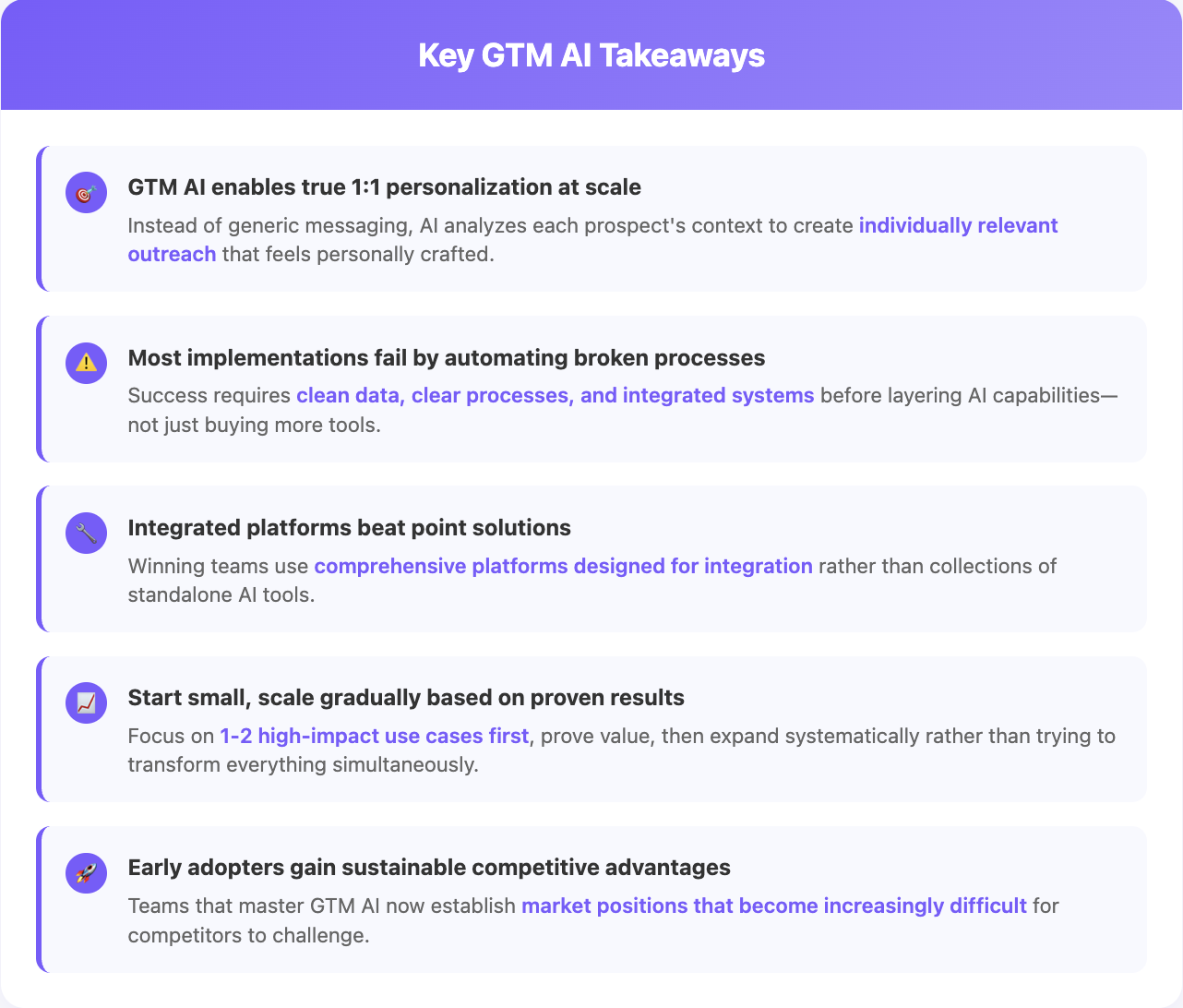
What GTM AI Actually Means (Beyond the Buzzwords)
Let me cut through the marketing noise and explain what GTM AI really encompasses. It's not just one tool or technique—it's an integrated approach that touches every part of your go-to-market process.
Intelligent prospect research means AI can analyze thousands of data points about companies and contacts in seconds. Instead of manually checking LinkedIn profiles, company websites, news articles, and funding announcements, AI pulls together comprehensive prospect intelligence instantly.
Dynamic segmentation goes far beyond static lists based on firmographics. AI creates behavioral micro-segments based on real-time activity, engagement patterns, and intent signals. A prospect who visited your pricing page three times this week gets treated very differently than someone who downloaded a blog post six months ago.
Predictive analytics helps you focus on opportunities most likely to close. Instead of treating all leads equally, AI scores prospects based on hundreds of variables and historical patterns from your successful deals.
Automated personalization generates custom content for each prospect using their specific context. AI doesn't just insert names into templates—it creates unique value propositions, relevant case studies, and compelling calls-to-action based on individual prospect profiles.
Real-time optimization means your campaigns get smarter continuously. AI analyzes response patterns, adjusts messaging, and optimizes timing to improve performance without manual intervention.
Companies winning with GTM AI aren't just automating existing processes. They're building fundamentally different go-to-market machines that operate at speeds and precision levels impossible for purely human teams.
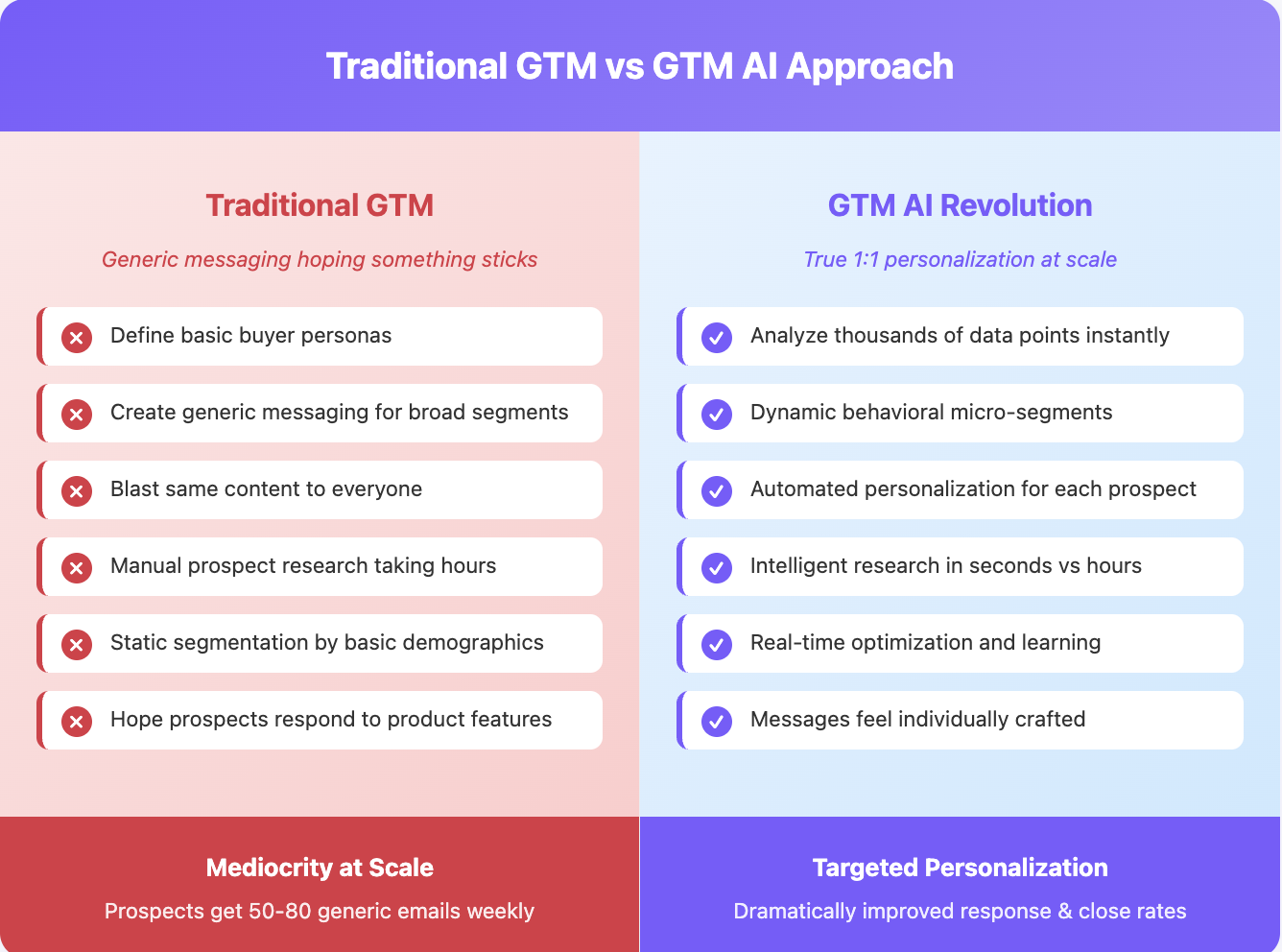
The Current State: Why Most GTM AI Implementations Fail
Most GTM AI implementations fail not because the technology doesn't work, but because teams approach AI with completely wrong assumptions.
The biggest mistake is trying to AI-ify existing broken processes. If your current segmentation is generic, your messaging is bland, and your data is messy, adding AI won't magically fix those problems. It'll just automate mediocrity at scale.
Another common failure is tool proliferation without integration. Teams buy ChatGPT subscriptions, lead scoring platforms, email automation tools, and conversation intelligence software, then wonder why nothing works together smoothly. Each tool has different data, conflicting insights, and separate workflows.
The third major issue is lack of data foundation. AI is only as good as the data it has access to. If your CRM is incomplete, your website tracking is basic, and your prospect intelligence is limited, even the best AI tools will produce mediocre results.
Companies often spend significant amounts on "AI transformation" only to see marginal improvements because they skipped the foundational work. The ones succeeding start with clean data, clear processes, and integrated systems before layering on AI capabilities.
How Leading Teams Implement GTM AI
The companies getting real results from GTM AI follow a completely different playbook. Instead of buying individual AI tools and hoping they work together, they build integrated systems designed from the ground up for AI-powered go-to-market.
- They start with data unification. Every prospect interaction, website visit, email engagement, and sales conversation feeds into a central intelligence system. This creates the detailed view of prospects that AI needs to generate truly relevant insights and recommendations.
- They automate research, not just outreach. Before any sales or marketing touch, AI pulls together complete prospect intelligence including recent company news, technology stack, growth signals, competitive landscape, and key decision-makers. This research happens automatically as new leads enter the system.
- They create dynamic, behavioral segments. Instead of static lists, prospects flow through behavioral triggers based on their actions. Someone who attends a webinar, visits pricing pages, and downloads case studies gets immediately flagged as high-intent and routed to specialized campaigns.
- They generate personalized content at scale. For each prospect, AI creates custom email sequences, relevant case studies, personalized demo requests, and specific value propositions based on their company situation and role responsibilities.
- They optimize continuously based on performance data. AI tracks which messages work for which types of prospects, adjusts timing based on response patterns, and refines targeting criteria based on conversion outcomes.
The result is go-to-market operations that feel personally crafted for each prospect while operating at massive scale. Response rates improve dramatically because every message feels relevant and timely.
Tools That Matter in 2025
The GTM AI environment is crowded with solutions promising miraculous results. Here's what actually delivers results based on comprehensive analysis:
For comprehensive data enrichment and automation, Databar.ai stands out as the most effective solution. Our platform combines 90+ data providers with AI-powered personalization and workflow automation. Instead of manually researching prospects or accepting incomplete data from single sources, Databar's waterfall enrichment achieves high data accuracy while generating personalized outreach at scale.
Copy.ai has positioned itself as a comprehensive GTM AI platform, moving beyond content generation to offer integrated workflows for research, outreach, and optimization. Their approach focuses on connecting different GTM functions rather than treating them as separate point solutions.
Gong provides revenue intelligence that analyzes all customer interactions to identify successful patterns, coaching opportunities, and pipeline risks. It's particularly valuable for understanding which messages and approaches work best with different prospect types.
For teams building comprehensive prospecting tools stacks, these platforms integrate well with specialized solutions focused on different aspects of the go-to-market process.
MarkovML specializes in GTM-specific AI agents that automate complex workflows like competitive analysis, content creation, and campaign optimization. Their platform is designed specifically for marketing and sales teams rather than general business use.
The key insight is that successful GTM AI implementations require platforms designed for integration, not collections of standalone tools. The winning approach combines data, intelligent automation, and continuous optimization in unified systems.
The Infrastructure You Need to Succeed
Building effective GTM AI requires more than just buying AI tools. You need proper infrastructure to support intelligent automation and data-driven decision making.
Clean, unified data is absolutely critical. Your CRM needs to be complete and accurate, your website tracking must capture detailed behavioral data, and your prospect intelligence should come from multiple reliable sources. AI amplifies whatever data quality you feed it—garbage in, garbage out applies more than ever.
Integration capabilities determine success or failure. Your AI tools need to work together seamlessly, sharing data and insights across platforms. If your lead scoring system can't talk to your email automation platform, you'll miss opportunities and create disjointed prospect experiences.
For teams looking to optimize their entire technology stack, understanding CRM enrichment tools that integrate with AI systems becomes crucial for maintaining data quality and workflow efficiency.
Proper measurement and attribution systems let you understand what's actually working. You need to track prospects through multiple touchpoints, measure AI impact on pipeline velocity and deal size, and optimize based on actual revenue outcomes rather than vanity metrics.
Team training and change management ensure adoption and effectiveness. Your sales and marketing teams need to understand how to work with AI insights, when to trust automated recommendations, and how to maintain the human touch that AI can't replicate.
Advanced Strategies the Winners Use
Beyond basic implementation, the most successful GTM AI teams employ sophisticated strategies that create significant competitive advantages.
Multi-channel orchestration coordinates touchpoints across email, LinkedIn, phone, and advertising to create cohesive prospect experiences. Instead of treating each channel separately, AI manages the entire conversation flow to optimize overall engagement and conversion.
Predictive lead scoring goes beyond traditional demographics and behaviors to identify prospects most likely to buy based on subtle patterns and signals. AI analyzes successful deals to identify characteristics and circumstances that predict future success.
Dynamic pricing and proposal generation customizes offers based on prospect situation, competitive landscape, and likelihood to close. AI can recommend optimal pricing strategies, contract terms, and implementation approaches for each specific opportunity.
Competitive intelligence automation monitors competitor activities, analyzes their messaging and positioning, and suggests strategic responses. AI tracks competitor website changes, content strategies, and market positioning to inform your own go-to-market decisions.
Customer lifecycle optimization uses AI to predict expansion opportunities, identify churn risks, and recommend retention strategies. The same intelligence used for prospect targeting helps maximize value from existing customers.
These advanced applications require sophisticated AI capabilities and clean data foundations, but they create sustainable competitive advantages that become stronger over time.
Common Pitfalls and How to Avoid Them
Here are the most costly errors and how to avoid them:
Don't try to automate everything immediately. Start with one or two specific use cases, prove value, then expand gradually. Teams that try to implement comprehensive AI across all GTM functions simultaneously usually fail because of complexity and change management challenges.
Don't ignore data quality issues. Clean up your CRM, implement proper tracking, and establish data governance before investing heavily in AI tools. Poor data quality will sabotage even the best AI platforms.
Don't expect AI to fix fundamental strategy problems. If your value proposition is unclear, your target market is poorly defined, or your sales process is broken, AI won't solve those issues. Fix strategic fundamentals first, then use AI to optimize execution.
Don't measure AI success with traditional metrics alone. Response rates and conversion rates matter, but also track time savings, deal velocity, and revenue per rep. AI's value often comes from efficiency gains that don't show up in basic funnel metrics.
Don't underestimate the learning curve. Your team needs time to understand AI recommendations, learn new workflows, and develop trust in automated systems. Plan for training, experimentation, and gradual adoption rather than immediate full-scale deployment.
The teams that succeed with GTM AI approach it as a long-term competitive transformation rather than a quick technology fix.
What GTM AI Looks Like in 2025 and Beyond
The evolution of GTM AI is accelerating rapidly. Based on current trends and emerging capabilities, here's what the next phase will bring.
AI agents will handle complete workflows autonomously. Instead of just generating suggestions, AI will manage entire sequences from prospect identification through initial qualification. These agents will research prospects, craft personalized outreach, handle initial responses, and escalate qualified opportunities to human reps.
Real-time personalization will become standard. AI will customize website experiences, email content, and sales presentations dynamically based on prospect behavior and context. Every touchpoint will feel individually crafted for each specific prospect.
Predictive market intelligence will guide strategy. AI will analyze market trends, competitive movements, and customer behavior patterns to recommend strategic adjustments before opportunities or threats become obvious.
Cross-functional AI orchestration will eliminate silos. Marketing, sales, and customer success will operate from unified AI platforms that coordinate activities and share insights seamlessly across teams.
Autonomous optimization will replace manual testing. AI will continuously test messaging variations, timing strategies, and targeting approaches, implementing improvements automatically based on performance data.
The companies that start building these capabilities now will have significant advantages as the technology matures. Early adoption creates data advantages and organizational learning that become difficult for competitors to replicate.
Building Your GTM AI Strategy: Where to Start
If you're ready to implement GTM AI effectively, here's a practical roadmap based on what actually works.
1: Data audit and infrastructure assessment. Review your CRM data quality, website tracking capabilities, and system integration points. Identify gaps that need addressing before AI implementation.
2: Define specific use cases and success metrics. Choose 1-2 high-impact areas where AI can deliver measurable improvements. Common starting points include prospect research automation, email personalization, or lead scoring enhancement.
3: Select and implement core platforms. Choose integrated solutions rather than point tools. Comprehensive platforms provide data enrichment and automation capabilities that form a strong foundation for GTM AI.
For teams considering different approaches to building their technology foundation, explore options for waterfall enrichment tools that integrate well with AI systems.
4: Launch pilot campaigns and measure results. Start with small prospect segments to test AI capabilities and refine approaches before scaling to larger audiences.
5: Optimize and expand based on early results. Analyze performance data, adjust targeting and messaging, and gradually increase campaign volume as you validate effectiveness.
6: Scale successful approaches and add advanced capabilities. Once basic AI implementations are working well, expand to additional use cases and more sophisticated automation.
The key is starting with solid foundations and scaling gradually based on proven results rather than trying to transform everything simultaneously.
The Future Belongs to GTM AI
The transformation where artificial intelligence moves from nice-to-have to business-critical for go-to-market success is accelerating.
GTM AI isn't about replacing human teams—it's about amplifying human capabilities to achieve results that were previously impossible. AI handles research, personalization, and optimization at superhuman scale, freeing your team to focus on strategy, relationship building, and complex problem solving.
The most successful implementations combine AI capabilities with human insight. AI provides intelligence and automation, while humans provide creativity, empathy, and strategic thinking. This collaboration creates go-to-market approaches that are both scalable and genuinely personal.
Starting now gives you the best chance for meaningful competitive advantage. The teams that master GTM AI early will establish market positions that become increasingly difficult for slower-moving competitors to challenge.
Your prospects expect personalized, relevant, timely communication. They want to feel understood and valued, not like another name on a generic email list. GTM AI makes delivering those experiences possible at the scale modern businesses require.
The future of go-to-market is already here. It's just not evenly distributed yet.
Frequently Asked Questions
What exactly is GTM AI and how is it different from regular marketing automation?
GTM AI goes far beyond traditional marketing automation by using artificial intelligence to make intelligent decisions, generate personalized content, and optimize performance continuously. While marketing automation follows pre-defined rules and workflows, GTM AI analyzes data patterns, predicts outcomes, and adapts strategies in real-time based on prospect behavior and market conditions.
How much should I expect to invest in GTM AI to see meaningful results?
Investment varies significantly based on company size and complexity, but most successful implementations start with moderate monthly investments for integrated platforms. However, the ROI typically justifies larger investments—teams often see significant improvements in lead quality and conversion rates within 3-6 months.
Can small companies compete with enterprise teams using GTM AI?
Absolutely. In fact, smaller companies often move faster and see results sooner because they have fewer legacy systems and processes to change. Modern GTM AI platforms are designed to scale from small teams to enterprises, so you can start with basic capabilities and expand as you grow.
What data do I need before implementing GTM AI effectively?
You need clean CRM data, website visitor tracking, email engagement history, and ideally some prospect intelligence. The key is data quality rather than quantity—it's better to have accurate information about fewer prospects than incomplete data about many. Most GTM AI platforms can help enrich existing data as part of implementation.
How long does it take to see results from GTM AI implementation?
Most teams see initial improvements within 2-4 weeks for basic implementations like automated prospect research and email personalization. More significant results typically appear within 2-3 months as AI systems learn from your data and optimize performance. Full transformation usually takes 6-12 months as processes mature and teams develop expertise.
Will GTM AI replace human sales and marketing professionals?
No, GTM AI amplifies human capabilities rather than replacing them. AI handles research, data analysis, and repetitive tasks, freeing humans to focus on strategy, relationship building, and complex problem solving. The most successful teams combine AI efficiency with human creativity and emotional intelligence.
How do I measure the success of GTM AI initiatives?
Track both traditional metrics (response rates, conversion rates, deal velocity) and AI-specific indicators (time saved per prospect, personalization accuracy, prediction accuracy). Focus on revenue impact rather than activity metrics—successful GTM AI should drive measurable improvements in pipeline quality, deal size, and sales cycle length.
What are the biggest risks or challenges with GTM AI implementation?
The main risks include poor data quality leading to inaccurate insights, over-automation that removes human touch, and tool proliferation without integration. The biggest challenges are usually change management and ensuring team adoption rather than technical issues. Starting with clear use cases and gradual implementation helps minimize these risks.
How do I choose between different GTM AI platforms and tools?
Focus on platforms that integrate multiple capabilities rather than point solutions. Look for comprehensive data enrichment, automation workflows, and performance analytics in unified systems. Consider starting with platforms that provide foundational capabilities across the entire GTM process rather than specialized tools for individual functions.
Related articles
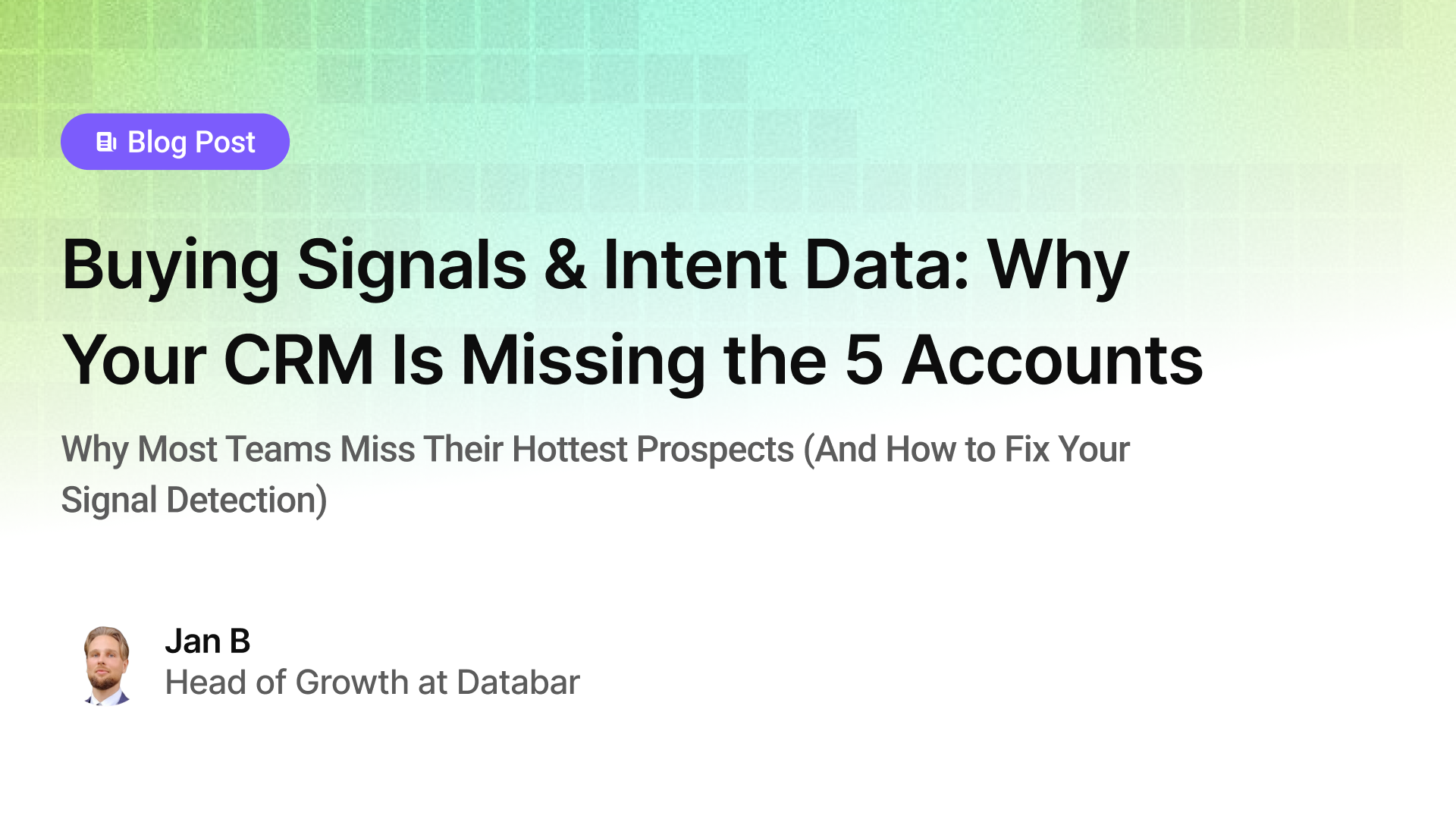
Buying Signals & Intent Data: Why Your CRM Is Missing the 5 Accounts
Why Most Teams Miss Their Hottest Prospects (And How to Fix Your Signal Detection)
by Jan, October 06, 2025

Lead Scoring & Account Segmentation: Why Most CRMs Get This Backward (And How to Fix It)
How to build a system that tells your team who to call, when, and why
by Jan, October 06, 2025
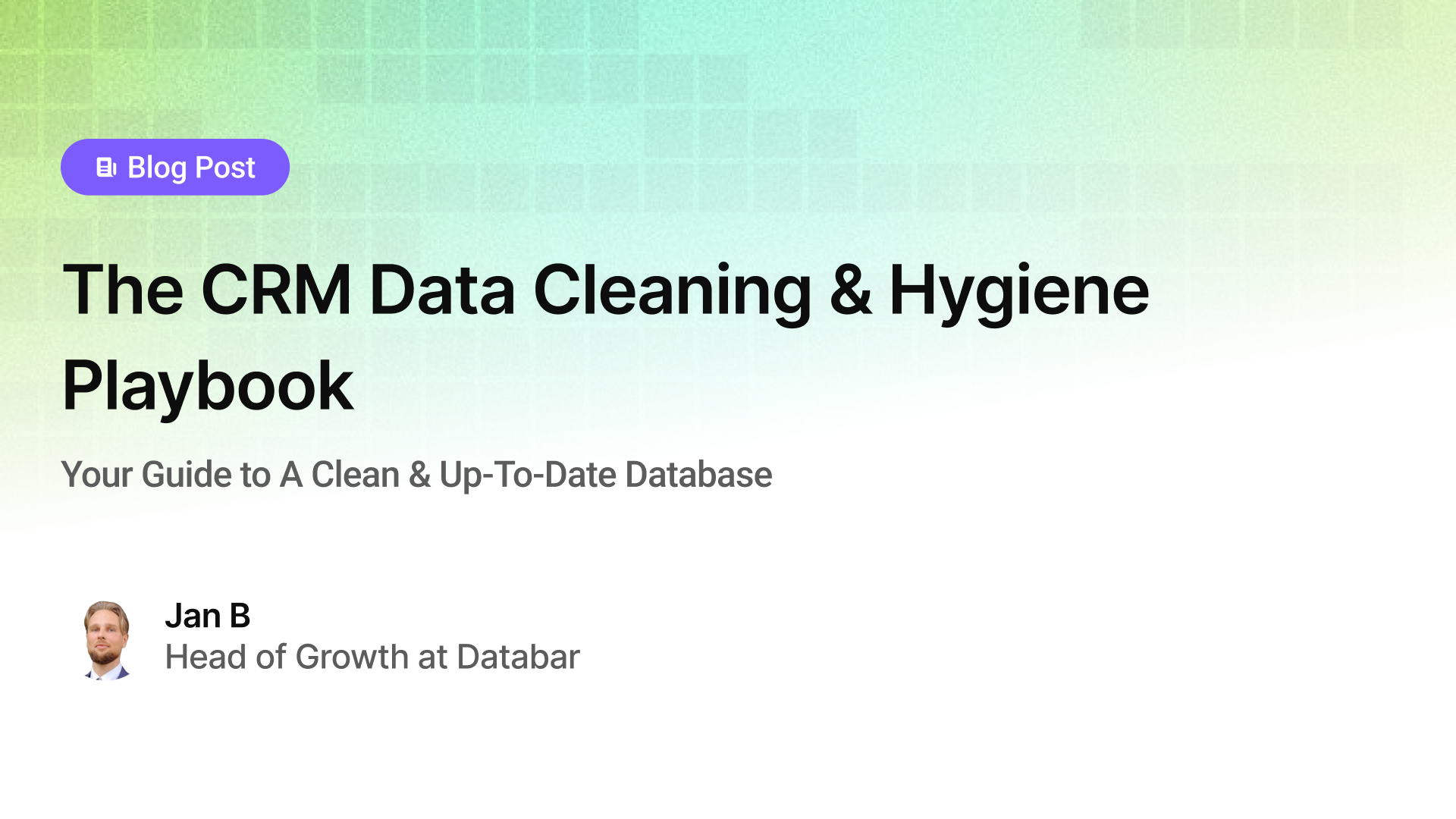
The CRM Data Cleaning & Hygiene Playbook
Your Guide to A Clean & Up-To-Date Database
by Jan, October 04, 2025
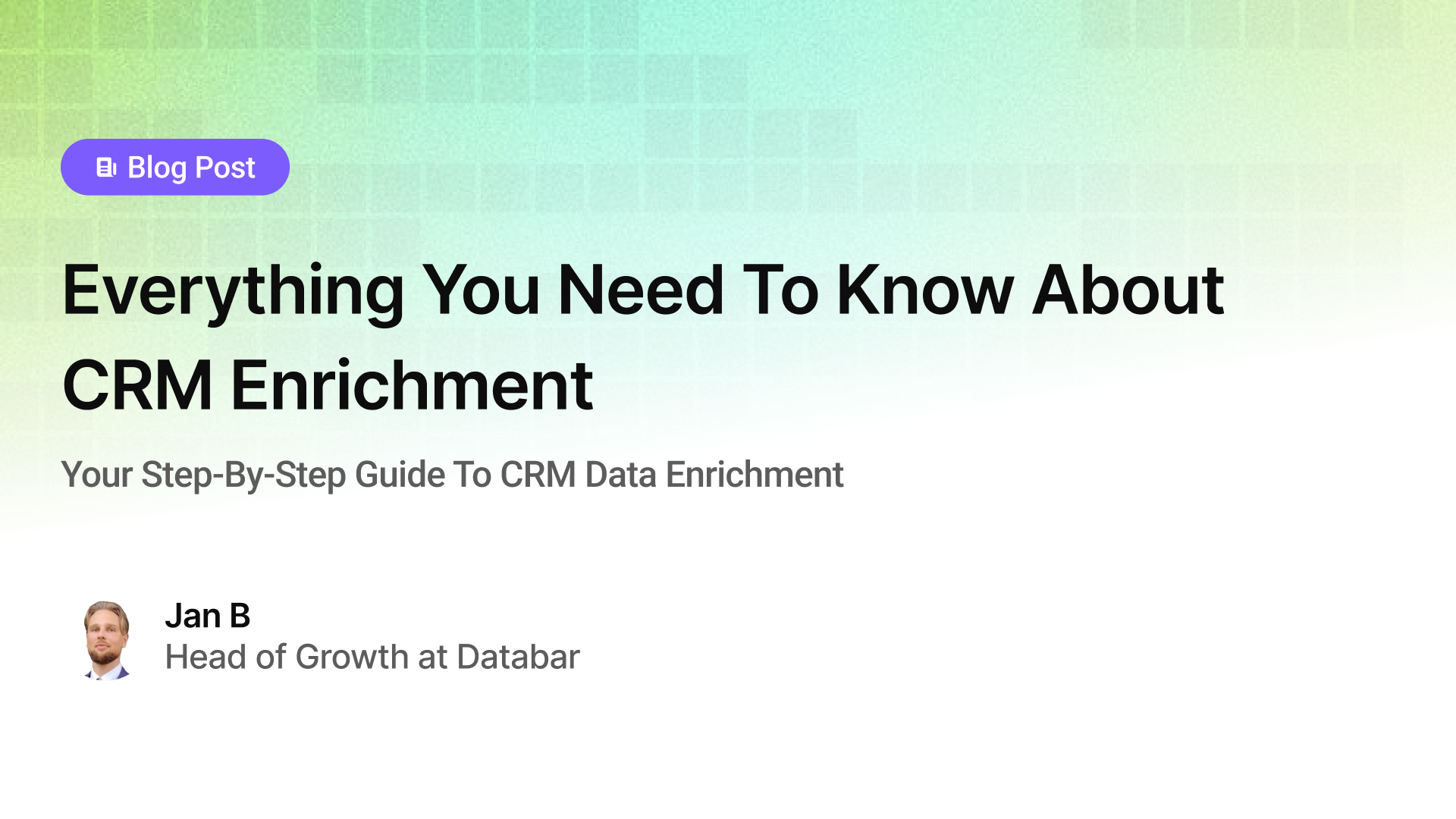
Everything You Need To Know About CRM Enrichment
Your Step-By-Step Guide To CRM Data Enrichment
by Jan, October 03, 2025

